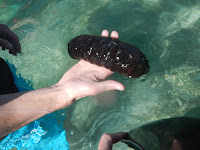 |
| I wish I could be such a famous individual as this Puerto Rican Boa! |
After about a mile of hiking we arrive at the mouth of the cave, our professor, Dennis, takes off at a run towards the side of the cave, and I can see why in seconds. He returns with a beautiful Puerto Rican boa, about five feet in length, in his hands. Dennis is a herpetologist, which means he studies reptiles, and he has been to this location several times before. I'm glad he knew exactly where to look to find and catch the boa. It is awesome to see these creatures up close.

The Puerto Rican Boa was once very abundant, but when the Spanish colonization occurred, oil from the snake's fat became a big export. This along with deforestation has led to a big decline in the snake's population. The female Puerto Rican Boa will usually only give birth to 23-26 live baby boas. And like most reptiles, the survival rate of those babies making it past their first year is not good. The Puerto Rican Boa can grow up to eight feet long, and they feed on small mammals and lizards. In these parts, bats are the main staple in their diet.
 |
| I reckon this is a type of flower bat but I am not sure. |
 |
| This is the Antillean Ghost-faced bat. It has a wicked ugly face. |
I think this is another type of flower bat
possibly the brown flower bat.
|
As darkness creeps up on the cave, bats come flying up and out to forage to insects. A Puerto Rican research student is along with us and he set up a harp net in the mouth of the cave. This net is a tangle-free trap that bats fly into, then slide down into a holding pouch where the researcher can safely pick them up for study. We catch several species of bats tonight including the Sooty Mustache bat, the Antillean Ghost-faced bat, and a few different flower bats. The research student is very knowledgeable and does an excellent job of teaching us about each species of bat we come across.
 |
| This fella is the sooty mustache bat. |
Now that we have caught a sufficient number of bats, we take a few extra minutes at the cave to try to get a few pictures. It is incredibly hard to take pictures of flying bats, but the night is young and the students with cameras are very eager (myself included). I flick my flash on and adjust my focus to the cave wall, then back off a bit. After a few pictures, I notice the boas dangling from the cave wall. They are patiently waiting for a bat to fly within striking distance. Then, I review one of my pictures and notice a boa has wrapped up on something. It has caught a bat! And now it is eating the bat! Super cool!
 |
| The Puerto Rican Boa eating a bat it captured. |
 |
| The Puerto Rican Tody was sleeping before we noisy bunch walked by. |
First, we find a Tody sleeping in a low tree and I only snap one quick photo and walk on to minimize my disturbance. Farther up the trail, the Puerto Rican research student is frantically motioning up into the tree branches and loudly whispering cuvieri! Cuvieri! It is a Puerto Rican giant anole, Anolis cuvieri, this is an absolute jewel! A very large and colorful anole, we wouldn't have found on this trip if it were not for our Puerto Rican friend. What an awesome find to end the night!
 |
| This Puerto Rican giant anole was sleeping on a branch about 20 feet above the ground. A good way to stay safe at night. |











































